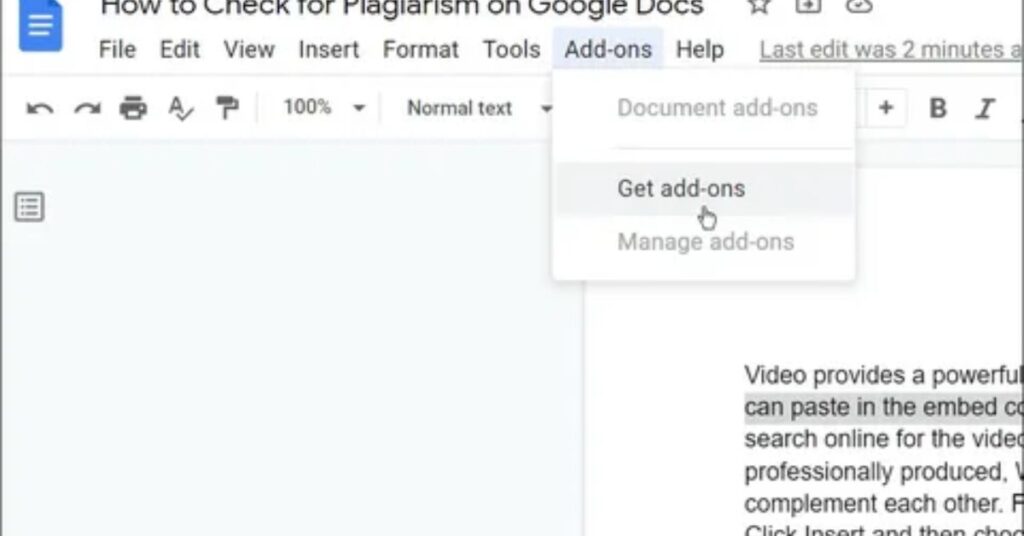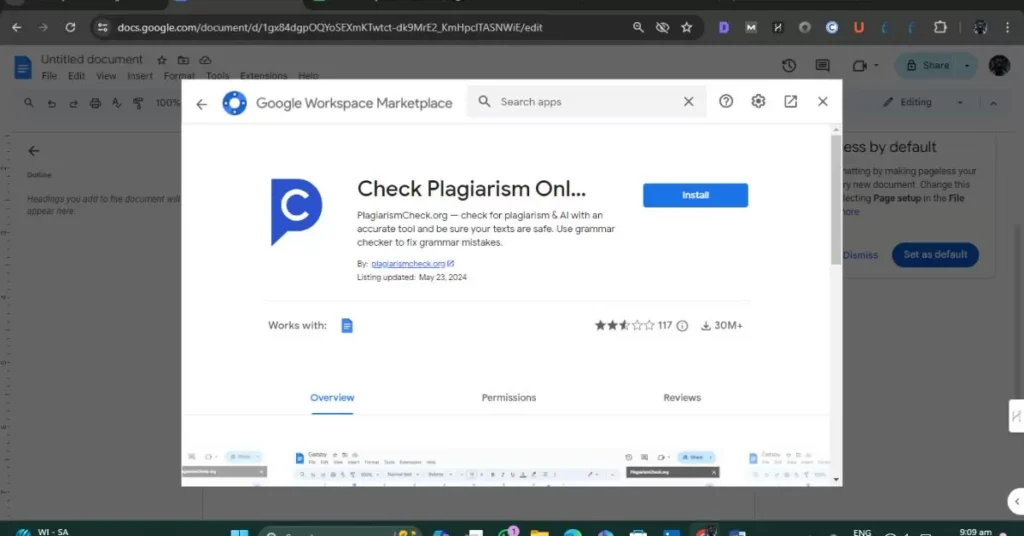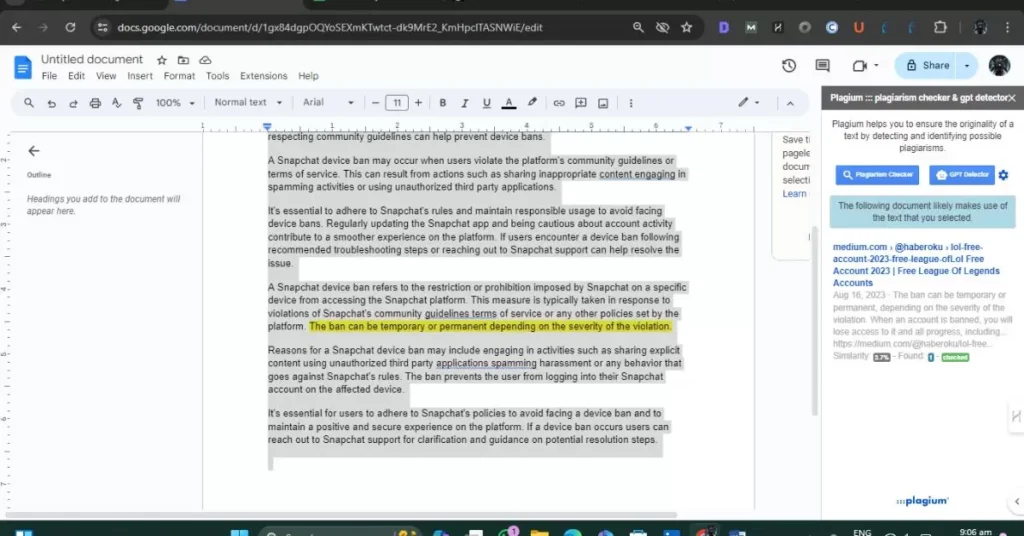Writing plagiarism-free content is crucial for maintaining academic integrity, professional credibility, and protecting your reputation.
Whether you’re a student, blogger, author, or professional writer, failing to ensure the originality of your work can have severe consequences.
But manually checking for plagiarism can be an incredibly tedious and time-consuming process. Fortunately, Google Docs offers a built-in plagiarism checker that can save you valuable time while safeguarding the integrity of your writing.
In this comprehensive guide, we’ll explore how to leverage Google Docs’ plagiarism checker to its fullest potential and share advanced techniques for ensuring complete originality. We’ll also cover the best practices for preventing plagiarism and maintaining a high standard of ethics in your writing process.
Why Prioritizing Plagiarism Checking is Essential
In our digital age, where information is readily available at our fingertips, the temptation to re-use content can be strong. Yet, representing someone else’s work as your own, whether intentionally or not, is considered plagiarism, and it can have severe ramifications:
Also Read This: What does the Bible say about artificial intelligence?
- Academic Penalties: For students, plagiarism can result in failed assignments, course failures, disciplinary action, and even expulsion.
- Legal Consequences: Plagiarizing copyrighted material is considered copyright infringement, opening you up to potential lawsuits and fines.
- Reputational Damage: Your credibility and trustworthiness as a professional, blogger, or writer heavily rely on producing original work. Plagiarism can irreparably tarnish your reputation.
- Loss of Integrity: Perhaps most importantly, plagiarism fundamentally undermines academic and creative integrity. It’s an unethical shortcut that devalues your work.
Clearly, the stakes for ensuring plagiarism-free content are high. That’s why having access to a quick, reliable plagiarism checker like the one built into Google Docs is so valuable.
How to Check Plagiarism in Google Docs Using the Built-In Tool
Google Docs simplifies the process of checking for plagiarism with its user-friendly interface. Here’s how you can take advantage of this time-saving feature:
- Open the document you want to check in Google Docs.
- In the top menu, go to Tools > Spelling and grammar.
- Click the blue “Check for plagiarism” button to initiate the scan.
- Google will analyze your document and highlight any passages or sentences that appear to be plagiarized from other web sources in a convenient sidebar.
- Review the flagged content carefully. Google’s checker may occasionally pick up properly quoted material or common phrases as potential plagiarism.
- For any genuine instances of plagiarism detected, you can easily rewrite those passages in your own words or properly quote and cite the borrowed material.
While Google Docs’ native checker is a convenient starting point, it’s essential to note that it may not catch all instances of plagiarism. Therefore, it’s advisable to supplement this tool with other dedicated plagiarism checkers for a more comprehensive analysis.
How to Check Plagiarism in Google Docs Using Add-ons?

In addition to Google’s built-in plagiarism checker, using third-party add-ons can provide a more robust plagiarism detection experience. Here’s how to use some of the top add-ons:
How to Use Plagium Add-on

- Install the Plagium add-on for Google Docs from the Google Workspace Marketplace.
- Open your document and go to Add-ons > Plagium > Check for Plagiarism.
- Plagium will scan your document and highlight any plagiarized content in a detailed originality report.
How to Use ProWritingAid Add-on
- Install the ProWritingAid add-on from the Marketplace.
- Open the document, go to Add-ons > ProWritingAid > Plagiarism.
- Click “Scan for Plagiarism” to check your document.
- ProWritingAid provides rewrite suggestions for any plagiarized text detected.
Using Semrush Writing Assistant
- Install the Semrush SEO Writing Assistant add-on from the Google Workspace Marketplace.
- Open your document and go to Add-ons > Semrush Writing Assistant.
- Semrush will automatically scan your document and provide inline suggestions to rephrase any plagiarized portions.
Using PlagiarismSearch Add-on
- Install the PlagiarismSearch add-on from the Marketplace.
- Open your document and go to Add-ons > PlagiarismSearch.
- Click “Check for Plagiarism” to initiate the scan.
- PlagiarismSearch will generate a detailed plagiarism report highlighting any matches found.
Utilizing these robust third-party add-ons alongside Google’s built-in tool provides a multi-layered approach to comprehensive plagiarism detection within Google Docs.
How to Check Plagiarism in Google Docs Using Third-Party Services

If you prefer not to use add-ons or want an additional layer of protection, you can also leverage third-party plagiarism checking services. Here’s how to check for plagiarism in Google Docs using popular services like Grammarly:
- Open the document you want to check in Google Docs.
- Click on the File tab and select Download > Microsoft Word (.docx) to export your document as a Word file.
- Open your web browser and navigate to Grammarly.
- Click on the “Upload” button and select the Word file you exported from Google Docs.
- Once the document is uploaded, click on the “Plagiarism” tab to initiate the plagiarism check.
- Grammarly will scan your content and provide a detailed report highlighting any instances of plagiarism detected.
By combining Google Docs’ built-in plagiarism checker with these third-party services and add-ons, you can establish a comprehensive, multi-layered system for ensuring the originality of your work.
Best Practices for Preventing Plagiarism
While plagiarism detection tools are invaluable resources, it’s wise to adopt day-to-day habits to prevent accidental plagiarism before it becomes an issue:
- Develop a robust note-taking and source documentation system: When conducting research and gathering information, meticulously record all source details. Use a citation manager tool to format citations automatically.
- Learn effective paraphrasing techniques: Putting information into your own words takes practice. Develop strategies like reading the source material and summarizing it without looking back at the original phrasing.
- Cultivate your unique writing voice: The more distinctive and recognizable your writing style is, the easier it will be to differentiate your work from plagiarized content.
- Set a zero-tolerance policy for plagiarism: Make it a point of pride and ethics to NEVER re-use concepts, ideas, or passages without proper attribution. Plagiarism should be 100% off-limits in your workflow.
- Leverage AI-powered grammar and writing assistants: Tools like SEMrush’s Writing Assistant use machine learning to help you rephrase text naturally and avoid plagiarism from the start of your writing process.
- Regularly discuss plagiarism and its consequences: Whether in the classroom or your workplace, keep the topic of academic integrity front and center. Share best practices with peers and uphold plagiarism checking as an expected standard.
Adopting a proactive, diligent approach to creating 100% original content will ensure you never have to worry about the consequences of unintentional or deliberate plagiarism tarnishing your work.
Conclusion
Writing original, plagiarism-free content has never been easier or more efficient thanks to Google Docs’ built-in plagiarism checker and the various third-party add-ons and services available. With just a few clicks, you can gain peace of mind that your document is free of duplicated passages from online resources.
And when you adopt plagiarism checking as an integrated part of your writing workflow instead of an afterthought. you’ll spend less time stressing about potential plagiarism and more time focused on creating high quality, ethically-sourced content.
FAQs
Is Google Docs’ plagiarism checker accurate?
While Google Docs’ built-in plagiarism checker is a convenient tool, it may not catch all instances of plagiarism, especially from non-web sources. It’s advisable to use it in combination with other dedicated plagiarism checkers and citation auditing for a more comprehensive analysis.
Does checking for plagiarism in Google Docs cost money?
No, Google Docs’ native plagiarism checker is completely free to use. But, some third-party add-ons and online services like ProWritingAid and Semrush may require paid subscriptions for advanced features.
Can I check for plagiarism in Google Docs offline?
No, Google Docs’ plagiarism checker requires an internet connection as it scans your document against online sources. Third-party add-ons and services may also require an internet connection.
Does the plagiarism checker work for all file types in Google Docs?
Google Docs’ native plagiarism checker works for documents created and edited within Google Docs. For other file types like Word documents or PDFs, you’ll need to use third-party tools or convert the files to Google Docs format first.
Can I automate plagiarism checks in Google Docs?
While Google Docs’ plagiarism checker itself cannot be automated, some third party add-ons like SEMrush’s Writing Assistant can provide real-time plagiarism scanning and suggestions as you write.
Also Read This: QuillBot Review 2024: Can it Be The Writing Assistant You Need?

As the admin of techtasion.com, I bring over 4 years of expertise in SEO and guest blogging. My passion lies in optimizing online presence and creating impactful guest posts. Dedicated to driving growth and delivering value through strategic digital content.
Pingback: What does the Bible say about artificial intelligence?